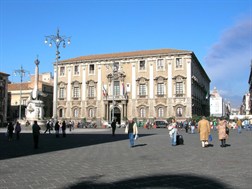The Palace of the Senate and the Fountain of the Elephant
 Piazza del Duomo has two more examples of the mastery of Vaccarini. In addition to the church of the Abbey of Saint Agatha, the illustrious architect also worked on the rebuilding of the Palace of the Senate, now the town hall of Catania and also known as the Palace of the Elephants. Vaccarini intervened on the initial draft by Giovan Battista Longobardo, modifying the table: he erected a façade divided by flat lesenes over a ground floor with diamond-shaped chamfered stone. To him we owe also the west, east and south façades, while the north façade was built in the second half of the eighteenth century by Carmelo Battaglia SantangeloThe architect from Catania Carmelo Battaglia Santangelo lived and worked almost exclusively in Catania, especially during the reconstruction after the earthquake of 1693. His most famous work is the northern façade of the Palace of the Elephants. His uncle was Francesco Battaglia, another important architect of Catania..
Piazza del Duomo has two more examples of the mastery of Vaccarini. In addition to the church of the Abbey of Saint Agatha, the illustrious architect also worked on the rebuilding of the Palace of the Senate, now the town hall of Catania and also known as the Palace of the Elephants. Vaccarini intervened on the initial draft by Giovan Battista Longobardo, modifying the table: he erected a façade divided by flat lesenes over a ground floor with diamond-shaped chamfered stone. To him we owe also the west, east and south façades, while the north façade was built in the second half of the eighteenth century by Carmelo Battaglia SantangeloThe architect from Catania Carmelo Battaglia Santangelo lived and worked almost exclusively in Catania, especially during the reconstruction after the earthquake of 1693. His most famous work is the northern façade of the Palace of the Elephants. His uncle was Francesco Battaglia, another important architect of Catania..
 Vaccarini is also the author of another symbol of the city of Catania. The Fountain of the Elephant was built between 1735 and 1737 and is located in the center of Piazza Duomo. The elephant, a symbol of the city since ancient times, probably from the period of domination by Carthage, was depicted in a statue, in lava stone, which stood within the walls of the city since the twelfth century. This statue, whose hind legs and trunk had been destroyed during the earthquake of 1693, was restored and placed on a white marble pedestal by Vaccarini. Jets of water spurt out of it which fall into a marble tank, in which the same pedestal is situated. On top of the statue of the elephant, to which Vaccarini added limestone eyes and tusks, there is a marble mantle on which the coat of arms of Saint Agatha is engraved. On the back of the elephant, which is facing with its trunk towards the cathedral of Saint Agatha, there is a 3,66 metre high granite obelisk, probably brought to Catania during the Crusades, from Syene, which presents Egyptian style figures which, however, have hieroglyphics which do not make sense. On top of the obelisk a globe was later mounted, crowned by a palm leaf, a symbol of martyrdom, and a branch of lilies, the symbol of purity. Over the globe, a metallic table bears the inscription dedicated to Saint Agatha with the acronym MSSHDPL which we already met, and is in turn surmounted by a cross.
Vaccarini is also the author of another symbol of the city of Catania. The Fountain of the Elephant was built between 1735 and 1737 and is located in the center of Piazza Duomo. The elephant, a symbol of the city since ancient times, probably from the period of domination by Carthage, was depicted in a statue, in lava stone, which stood within the walls of the city since the twelfth century. This statue, whose hind legs and trunk had been destroyed during the earthquake of 1693, was restored and placed on a white marble pedestal by Vaccarini. Jets of water spurt out of it which fall into a marble tank, in which the same pedestal is situated. On top of the statue of the elephant, to which Vaccarini added limestone eyes and tusks, there is a marble mantle on which the coat of arms of Saint Agatha is engraved. On the back of the elephant, which is facing with its trunk towards the cathedral of Saint Agatha, there is a 3,66 metre high granite obelisk, probably brought to Catania during the Crusades, from Syene, which presents Egyptian style figures which, however, have hieroglyphics which do not make sense. On top of the obelisk a globe was later mounted, crowned by a palm leaf, a symbol of martyrdom, and a branch of lilies, the symbol of purity. Over the globe, a metallic table bears the inscription dedicated to Saint Agatha with the acronym MSSHDPL which we already met, and is in turn surmounted by a cross.
